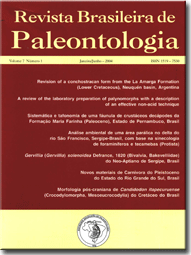PHYLOGENETIC EIGENVECTOR REGRESSION IN PALEOBIOLOGY
DOI:
https://doi.org/10.4072/13Abstract
ABSTRACT – Phylogenetic Eigenvector Regression (PVR) is a fl exible comparative method that allows testing severalhypotheses on phylogenetic signal and correlated evolution among traits. Selected phylogenetic eigenvectors extracted from a
phylogenetic distance matrix among taxa allow representing their phylogenetic relatedness in a raw-data form (i.e. instead of
a distance matrix) and can then be used as explanatory variables in statistical models aiming to estimate phylogenetic signal or
phylogenetically corrected correlations. Because of the growing use of PVR by paleobiologists in recent times, here the main
theoretical/statistical basis of the method and the developments made in the 15 years after its original proposition are reviewed,
highlighting further potential applications in paleobiology. For the fi rst time, a multivariate extension of the phylogenetic
signal-representation curve for estimating phylogenetic signal is presented. Another innovation is to show how PVR can be
used to assess morphological disparity in a phylogenetic context. A dataset of cranial morphology and function of 35 theropod
dinosaur genera is used to illustrate the applications of PVR and how it can be used to answer four questions: (i) what are the
phylogenetic patterns in theropod skull shape? (ii) is possible to tease apart the evolutionary models underlying variation in
traits? (iii) how are evolutionary history, function, and diet related to variation in theropod skulls? (iv) what are the evolutionary
components of morphological disparity in theropod skulls? Answering these questions provide a roadmap for using PVR to
address a range of issues relevant to contemporary paleobiology research programs.
Downloads
Download data is not yet available.
Downloads
Published
2017-09-30
How to Cite
Ribeiro, A. M. (2017). PHYLOGENETIC EIGENVECTOR REGRESSION IN PALEOBIOLOGY. Revista Brasileira De Paleontologia, 7(1). https://doi.org/10.4072/13
Issue
Section
Articles
License
This is an Open Access article distributed under the terms of the Creative Commons Attribution-NonCommercial-NoDerivatives license (http://creativecommons.org/licenses/by-nc-nd/4.0), which permits non-commercial re-use, distribution, and reproduction in any medium, provided that no alterations are made and the original article is properly cited. The written permission of Revista Brasileira de Paleontologia must be obtained before any commercial use and/or adaptation of the article.







